

Taking Notes for the Listening Section of the TOEFL® Test
Taking Notes for the TOEFL Listening A Step-by-Step Guide
Let’s start by addressing the big, fat elephant in the room.
Every student’s favorite question…
“Do I have to take notes?”
No, you don’t have to take notes.
Say what?
Seriously. Many students find the TOEFL Listening Note taking process so difficult that they give up and just listen without taking notes.
And, some do well.
However, almost none score above a 25/30 in the TOEFL Listening section.
Most TOEFL Listening passages are at least five minutes long, and they are jam-packed with content.
It’s nearly impossible to remember enough information to answer every question correctly, which is why most who don’t take notes fail to score higher than a 25.
But if you’re anything like us, you want to be at your best. You want to maximize your potential and reach the highest possible score you can in the listening section.
And we want to show you how to do it.
We are going to take you step-by-step through the notetaking process for the TOEFL Listening so you know exactly what you need to do to take more notes in less time.
We will start with the three TOEFL Listening notetaking tips you must master first. And from there, we are going to use those tips to help us write notes for listening to conversations and lectures.
Let’s do it!
Oh snap, before I forget, let me add a link here to our free download of 100 Practice Questions for the TOEFL Listening Section.
We specifically designed these questions for students like you who are looking to build their TOEFL Listening note taking strategies.
Check it out and let us know if you have any questions.
How to take notes in the TOEFL Listening section?
All right, back to the lesson.
Three rules for taking TOEFL notes
- Write down only nouns, verbs, and adjectives (content words)
- Write down consonants (vowels are hardly ever needed)
- Know your core symbols
#1 Write down only nouns, verbs and adjectives
Let’s use some fancy vocabulary here.
You should write down only content words, and leave out function words.
Content words are meaningful words that contain significance, such as people or places, actions, and descriptions.
Function words are things like prepositions, articles, auxiliary verbs (have), and modals (may, could), which provide almost no useful information about the material.
Well, there are SOME cases in which function words come in handy. They may help you in instances where they are essential to understanding the main idea of a given sentence, for example, “He’s in the car”, and “He’s under the car,” carry a significant difference in meaning. Still, for the most part, you should focus only on writing down nouns, verbs, and adjectives.
Let’s practice. Only jot down the content words that will be most helpful in aiding your memory.
Insomnia, a consistent difficulty in falling or staying asleep, is the most common of the sleep disorders.
Insomnia common disorder
It is not uncommon for people suffering from insomnia to experience increased levels of anxiety about their inability to fall asleep.
More anxiety falling asleep
Chronic insomnia is almost always associated with feeling overtired and may be associated with symptoms of depression.
Chronic symptoms overtired depression
Not so bad, right?
Now let’s move on to the next rule.
#2 Write down consonants, not vowels
- sleep → slp
- symptoms → smptms
- depression → dprsn
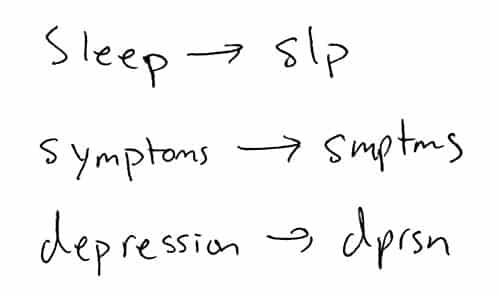
- anxiety → anxty
- create → crete
- treaty → trty
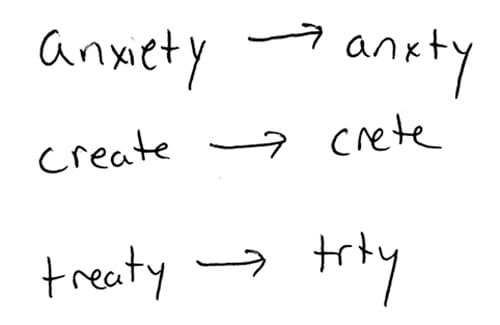
Experiment and find an approach that works best for you.
Let’s try those sentences again, this time incorporating rule #2, only consonants.
Insomnia, a consistent difficulty in falling or staying asleep, is the most common of the sleep disorders.
- Insma cmn dsrdr
Now try the next two on your own…
It is not uncommon for people suffering from insomnia to experience increased levels of anxiety about their inability to fall asleep.
Chronic insomnia is almost always associated with feeling overtired and may be associated with symptoms of depression.
Exciting right?
I know, I know, the TOEFL can be a bit dry sometimes, so, if you are reading this right now I am so proud to be able to share this information with someone as motivated as you are to achieve your TOEFL score.
Let’s get back into it.
There’s one more important rule to consider when taking notes for the TOEFL Listening section.
#3 Know your core symbols
Below is a chart of the nine most important symbols to incorporate in your TOEFL Listening note taking.
Important Symbols |
|
|---|---|
| Symbol | Meaning |
| + | benefit, positive, also, as well, together, combined |
| Ø | not, no, negative, stop |
| ? | I'm not sure, lecturer not sure, question |
| ↑ | rising, increase, improve, positive, beneficial |
| ↓ | going down, decreasing, problematic, hurting |
| → | leads to, results in, follows |
| = | is equal to, the same as, something is like/similar to |
| ≠ | not equal to, not the same as, dissimilar |
| / | and, connected to |
Symbols are important. Not only do they save time, but also increase the amount of information you write down about the listening passages.
But if you are new to using symbols, do NOT try to incorporate all nine of these symbols in your notes at once.
The key is to keep it simple. Start with just two or three. I suggest the arrows since they are the easiest to understand.
As you start to feel more comfortable, incorporate more of these symbols in your note taking listening exercises. Remember, it’s hard to change a habit. You have been taking notes your own way for years. It will take some time to get used to all of this information, so take it slow.
Let’s look at those sentences again. So far we have noted the content words and omitted most of the vowels, now let’s include a few symbols.
Insomnia, a consistent difficulty in falling or staying asleep, is the most common of the sleep disorders.
- Insmna = cmn slp dsrdr
It is not uncommon for people suffering from insomnia to experience increased levels of anxiety about their inability to fall asleep.
- ↑ anxty ⌀ aslp
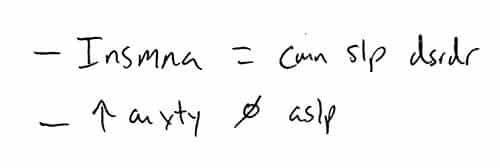
You try the last one…
Chronic insomnia is almost always associated with feeling overtired and may be associated with symptoms of depression.
See. It’s getting easier already!
Right?
Right…
How to take notes for TOEFL Listening Conversations
- Write down content words
- Write down consonants
- Know your core symbols
- The student presents a problem
- The campus worker offers a solution
- They discuss how to solve the problem
- problem
- solution
- steps

- S = student
- W = campus worker
- Things you could write down – relatively easy to remember, so you probably don’t have to write it down
- Things you should write down – important information that is slightly more difficult to remember
- Things you must write down – information that is definitely important and difficult to remember
Get access to TST Prep’s Complete Test #13 so you can learn exactly what to expect on test day.
Go to the listening section and practice taking down notes for the two conversations. Don’t try to write down everything, but instead focus on the structure of the TOEFL Listening conversation and the most important points.
- could
- should
- must
Your Notes |
|
|---|---|
| could |
|
| should |
|
| must |
|
Stop trying to understand every detail of the listening. Start to focus on points you must write down, like assignment requirements and rules that need to be followed, which are much more likely to help you answer the questions.
How to take notes for TOEFL Listening Lectures
Most TOEFL teachers and books tell you that when you are listening to the lecture, you have to write down the main idea. Well, I have some surprising news…
Despite what you might think, the main idea of the lecture is not the most important thing you want to look for.
That’s right, you do NOT have to write down the main idea in your notes.
- “Why does the professor say this?”
- “What does the professor want the students to know by the end?”
- “Why is this information important?”
- “How does the professor elaborate on, explain, or illustrate the main idea?”
Your job is NOT to understand every word you hear, but instead to identify the main idea and the important points that elaborate on the main idea.
- Things you could write down – relatively easy to remember, so you probably don’t have to write it down
- Things you should write down – important information that is slightly more difficult to remember
- Things you must write down – information that is definitely important and difficult to remember
Your Notes |
|
|---|---|
| could |
|
| should |
|
| must |
|
Practice makes perfect?
I know this TOEFL stuff can get a bit frustrating sometimes. So don’t hesitate to reach out and let us know if you have any questions or concerns: contact@tstprep.com
Did we miss anything? Or do you have a comment?
Please add your ideas in the comments section below.
We promise to respond to every single one!
Also read:
Create a FREE
Practice Account
Join now and start learning with our free materials



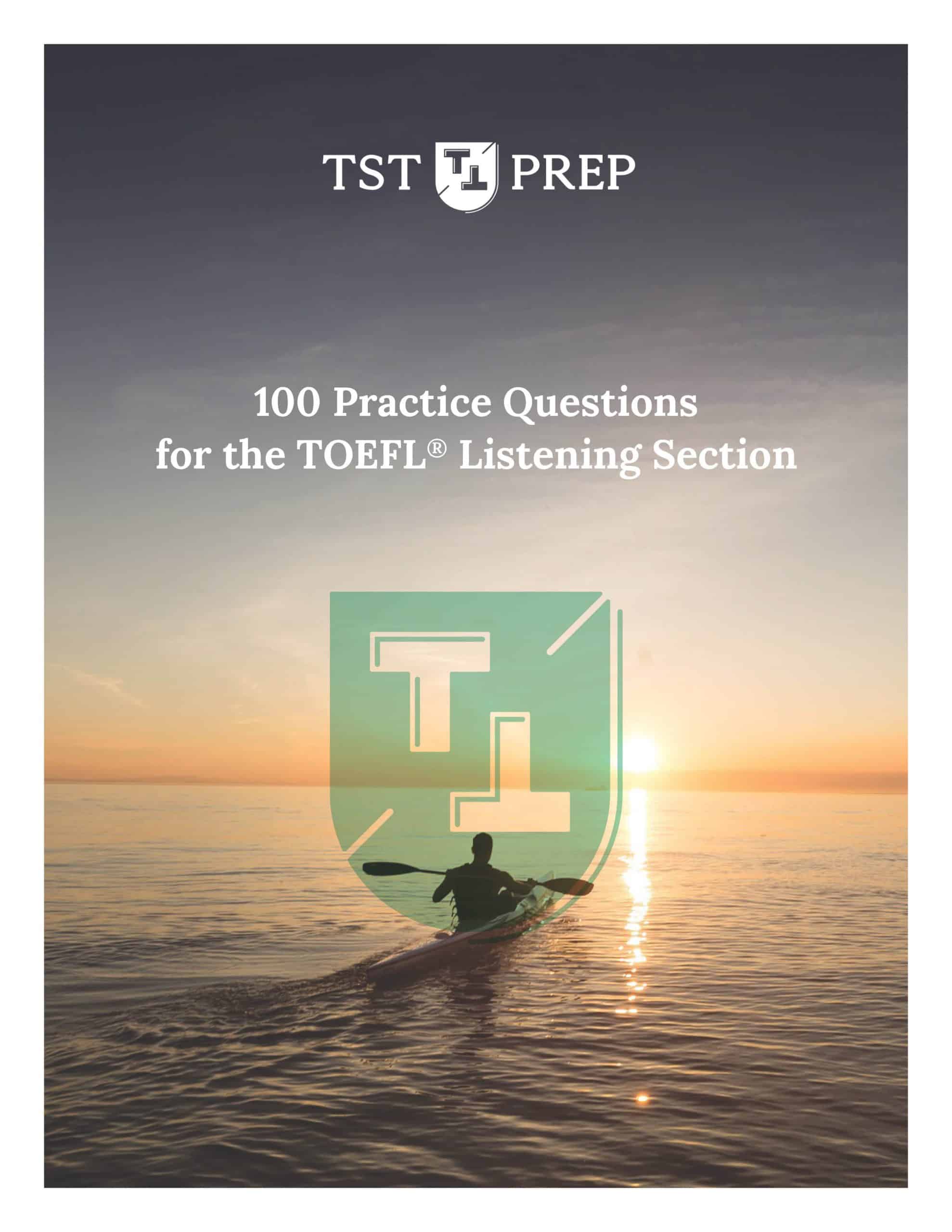
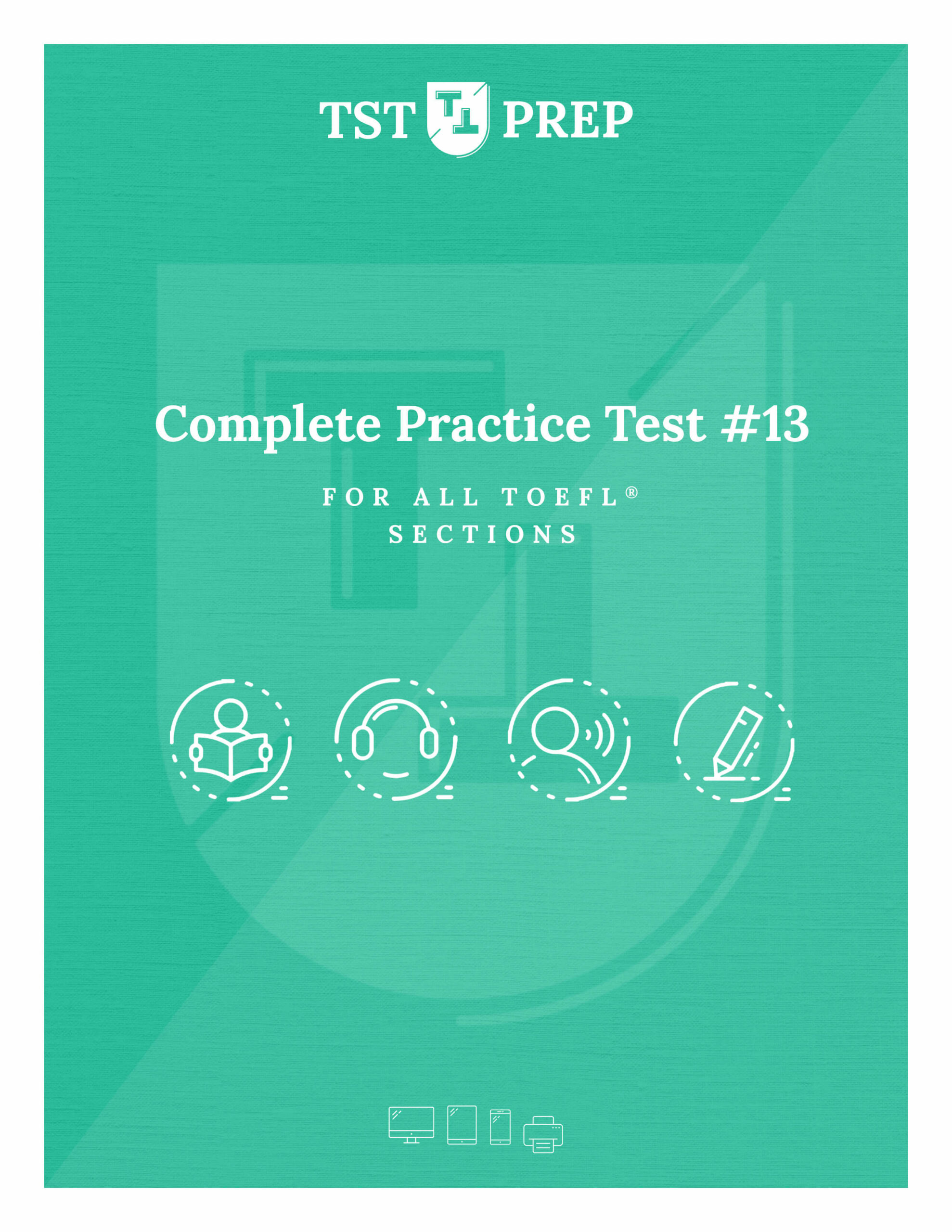




45 Comments
Comments navigation
Frankie
Josh, Could you please clarify a couple of things about note-taking in TOEFL Ibt? With what tools and in which parts of the exam can candidates take notes during TOEFL Ibt? If I am not mistaken, no pens or pencils are allowed to be used, only earsable markers. Is that correct? What do you personally recommend using? Whiteboard? Is note-taking only allowed during the Listening and Speaking parts? (Can templates be used during the Writing section?) Thank you! Frankie
Josh
Hi Frankie, are you taking the home edition or going to a test center, because that will change the answer? 🙂
Kelly Bruno
Hey Josh, I’ve noticed that when I practice listening questions, I consistently struggle with those who ask about how the professor arranged the lecture. I was wondering if you have any tips or strategies that might help me improve in this specific area. Your insights would be really valuable to me as I work on enhancing my listening skills. Thanks!
Josh
Great question. One suggestion is to look at your notes. Your notes should follow a similar structure as the lecture. For example, if in your notes, you write down some information about apples, then oranges, then lemons, you can guess that the structure is the professor is organizing his lecture by talking about fruit and then giving examples of the different kinds, etc.
Honey
Hey Josh! Thanks for all of your awesome tips. I score mostly 27-8 on my listening practices, but the points I lose are always in the lectures and because I miss some details between taking notes and listening. What do you suggest for this problem?
Josh
Hi there and thank you for your question. First of all, congrats on your score. It’s very difficult to score 27 or higher in any section of the iBT. If you are scoring that high, it sounds like you already have a great approach and just once in a while get something wrong. I would track the questions you are missing to see if there is any pattern. Is there a certain type of question? Try to find some pattern and focus on minimizing it. I hope that helps a bit.
Comments navigation